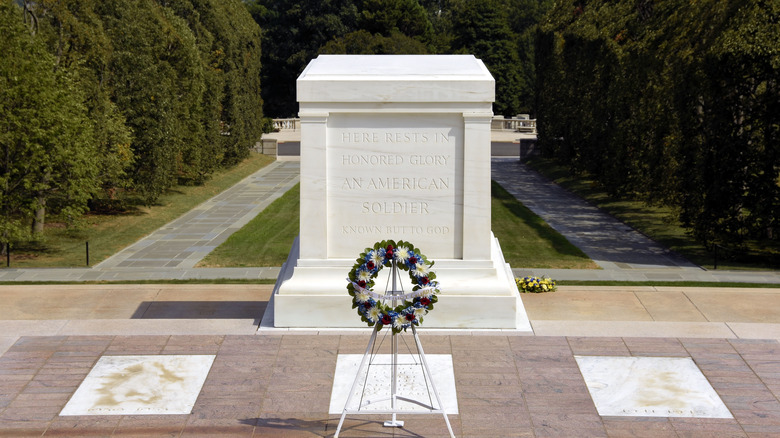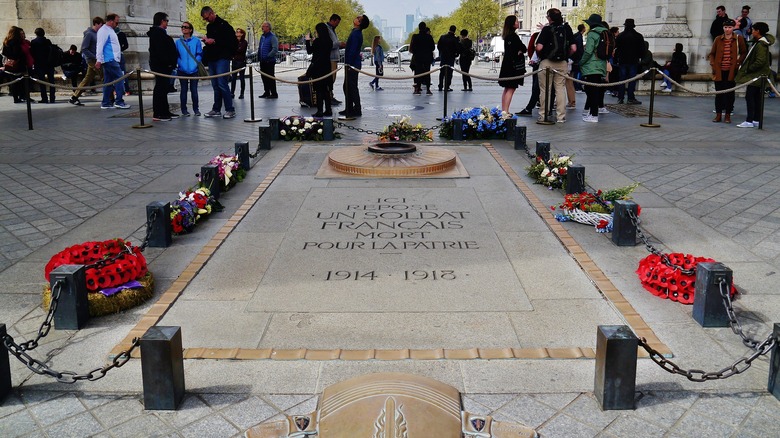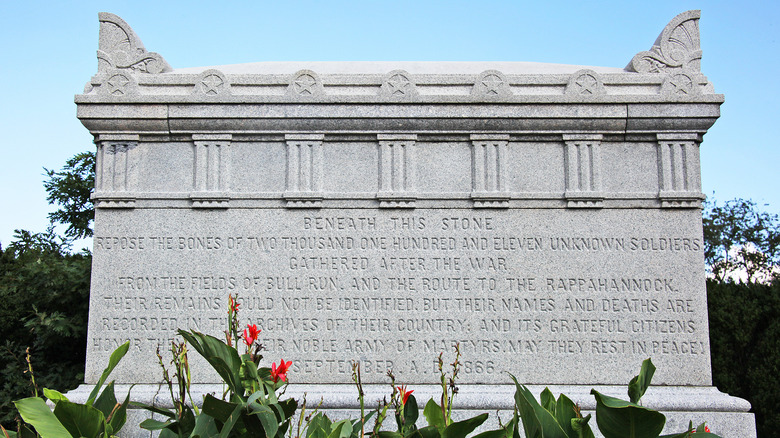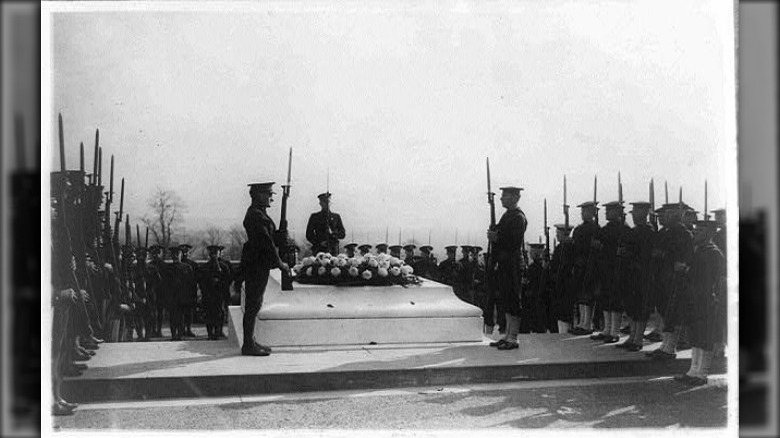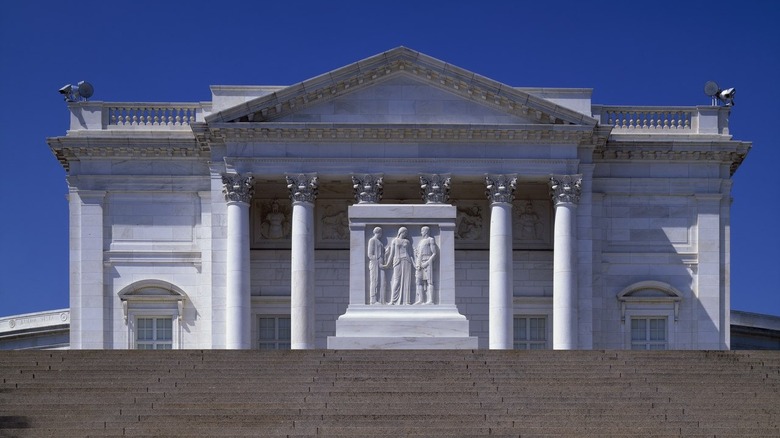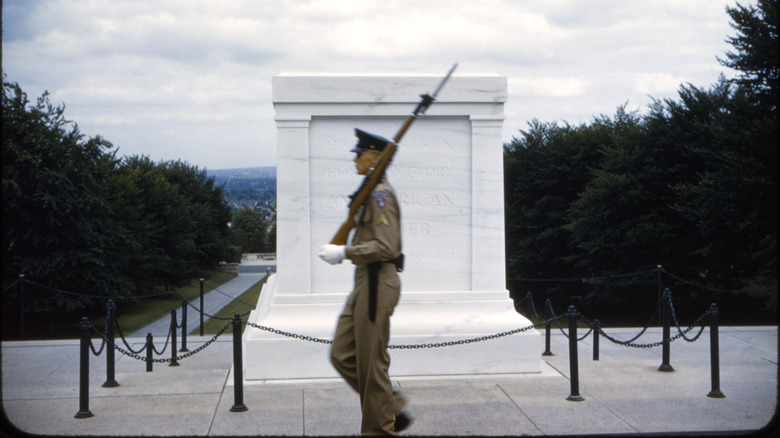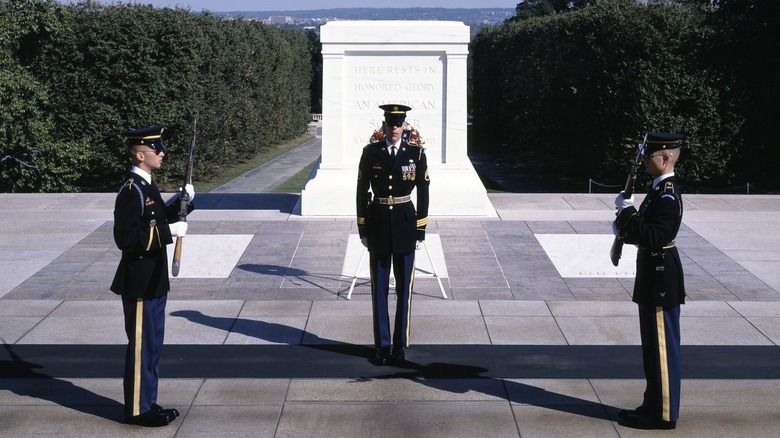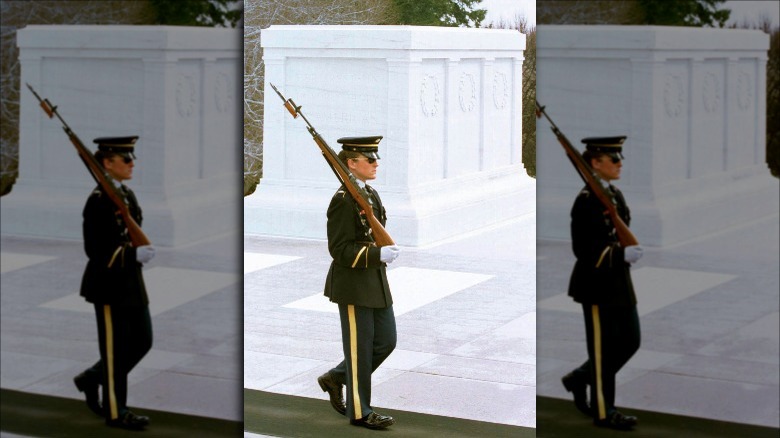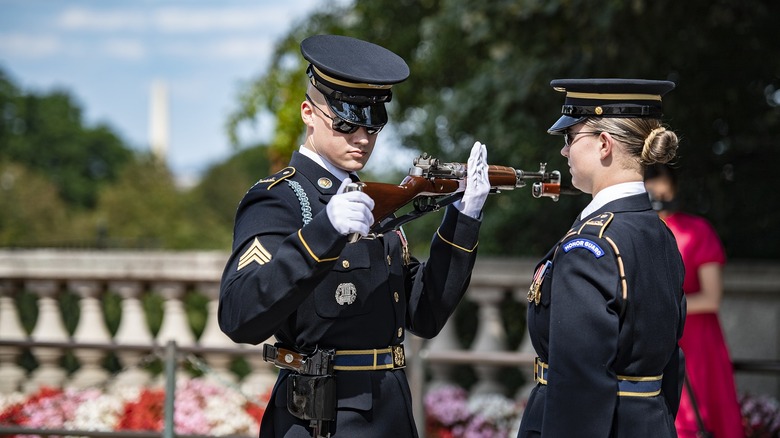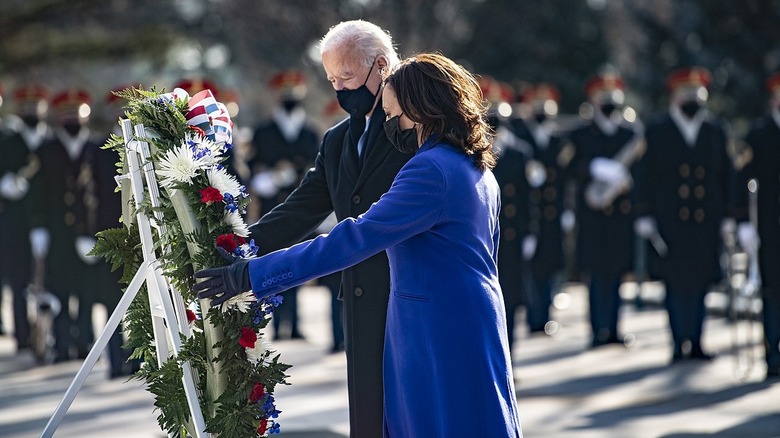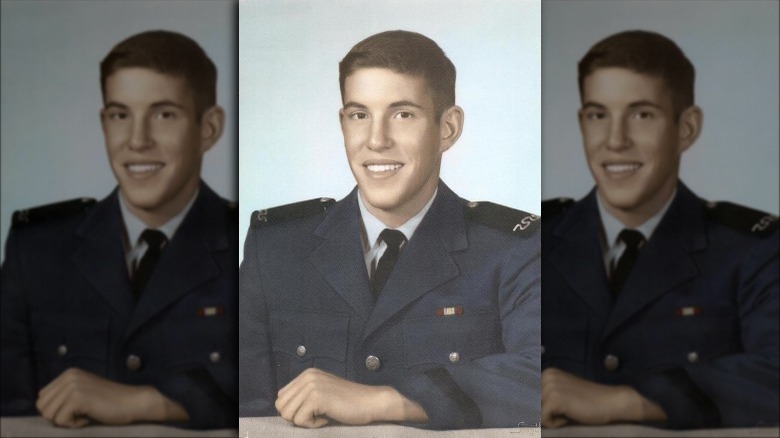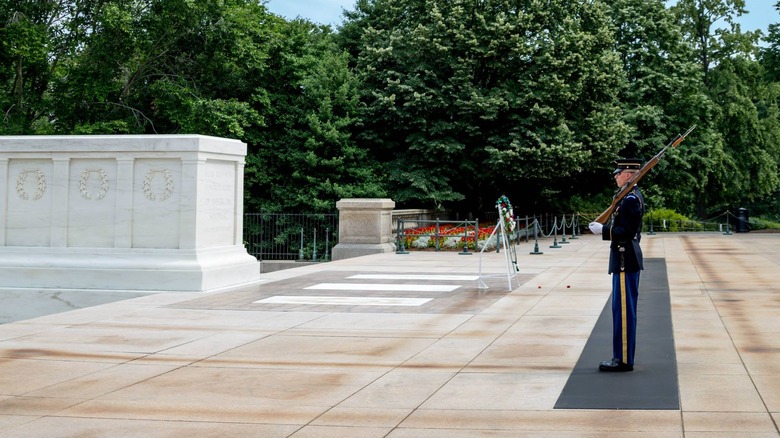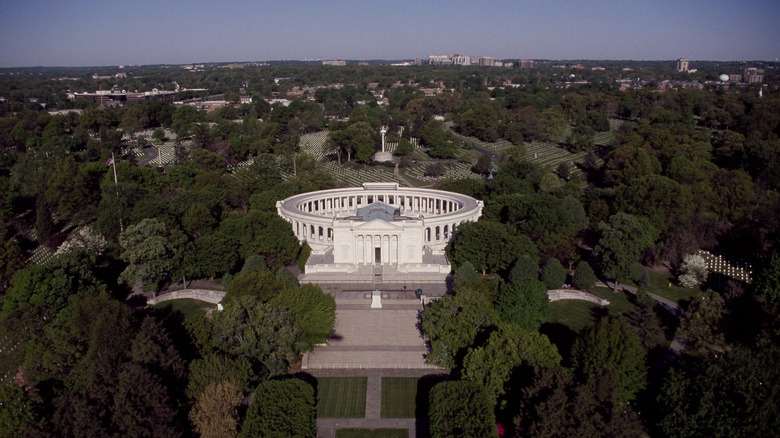The Untold Truth Of Arlington's Tomb Of The Unknown Soldier
One of the most well known and striking features of Arlington National Cemetery, located just outside of Washington, D.C., is surely the Tomb of the Unknown Soldier. Those who visit the tomb encounter three white marble slabs, a white marble sarcophagus, and a tomb guard from the U.S. Army keeping watch at all hours. Occasionally, the tomb will be the focus of a memorial ceremony, such as when a visiting dignitary places a wreath in front of the monument as a memorial.
According to Arlington National Cemetery, the tomb was originally dedicated in 1921 and was originally a rather unobtrusive marble slab. A decade later, a marble sarcophagus was erected on the site, featuring carved figures and an inscription that reads "Here rest in honored glory an American soldier known but to God."
Despite its relatively young age, this memorial has a complex history. From its inspiration to how it operates today, this is the untold truth of Arlington's Tomb of the Unknown Soldier.
It's not the first monument honoring unidentified military dead
The Tomb of the Unknown Soldier at Arlington National Cemetery is far from the first of its kind. In fact, it's a few decades late, at least when it comes to monuments dedicated to unknown soldiers. One of the first of that category was a statue dedicated in Denmark in 1858, according to the Museerne i Fredericia. Known as The Valiant Private Soldier, it commemorates a Danish military victory from 1849.
The bronze statue shows a sort of amalgamated soldier of the time, then an unusual move. Previously, monuments of this sort depicted a known person, and usually someone of high rank and renown. While The Valiant Private Soldier is arguably a forerunner of other unknown soldier monuments, it doesn't house any soldiers' remains and the gravesite includes their names (though not individual headstones). However, the nearby Soldier's Grave contains the remains of 458 named men from the same 1849 battle (via Visit Fredericia).
Tombs to accommodate the remains of unknown soldiers were also dedicated in France and Britain in 1920, a year before the U.S. Tomb of the Unknown Soldier. Britain's grave lies in Westminster Abbey, and it contains the remains of an unidentified soldier brought back from the World War I battlefields of France. A similar interment at the Arc de Triomphe in Paris contains an unknown French soldier, according to "The Living Unknown Soldier: A Story of Grief and the Great War."
It's not the first tomb for unknown soldiers in Arlington
Within the United States, there are a number of scattered monuments to unidentified soldiers, such as the Tomb of the Unknown Soldier of the American Revolution in Alexandria, Virginia (via Atlas Obscura). Even on the grounds of Arlington National Cemetery, the Tomb of the Unknown Soldier isn't exactly a singular monument. The national military cemetery is also home to the Civil War Unknown Monument, the first in the burial grounds dedicated to and containing the remains of unknown service members.
According to Arlington National Cemetery, this grave site was dedicated in September 1866, shortly after the end of the American Civil War. The above-ground stone monument stands on top of a vault that contains the remains of over 2,000 unidentified Civil War combatants from the battlefield around Manassas, Virginia. An estimated 1,800 individuals were retrieved from Bull Run field alone, while others were recovered from the road to nearby Rappahannock.
Because identification of remains was relatively unsophisticated at the time, it's not clear who is buried in the vault or even what side they fought for. The U.S. National Park Service notes that the common assumption is that the memorial contains both Union and Confederate combatants. PBS further notes that it was later honored in an 1873 service. President Ulysses S. Grant led the memorial, which included a poem and a hymn sung by orphans.
The idea for an official Tomb of the Unknown Soldier came after World War I
Inspired by the British and French tombs dedicated to unknown military combatants, the U.S. began planning for its own resting place dedicated to unidentified soldiers. PBS reports that Congress eventually passed a resolution to create an American version of the tomb. According to History, the Tomb of the Unknown Soldier was dedicated on November 11, 1921. An unidentified American soldier was interred there on Armistice Day, which effectively marks the end of World War I.
Yet, as solemn and reverent as the ceremony must have seemed, it didn't come about with conflict behind the scenes. Per PBS, some military officials were reluctant to identify remains as unknown before exhausting all avenues of identification first. Secretary of War Newton D. Baker even said as such to a committee of Senators. His replacement, John W. Weeks, was likewise cautious of deeming a soldier to be unidentifiable while there might still be a chance of reuniting a family with the remains of their loved one. Yet, he went somewhat further than his predecessor and conceded that an appropriately unknown candidate could be selected in time for Armistice Day.
Selecting remains for the tomb was random
Selecting remains for the Tomb of the Unknown Soldier was always going to be difficult. There was the emotional toll of the process, but there were also thorny practicalities that had to be addressed even in the midst of the remembrance. First, organizers had to be fairly certain that the remains in question would never be identified.
Officers have generally been given the task of randomly selecting one individual for interment in the tomb. But that doesn't exactly happen on the battlefield or in a foreign country. According to PBS, the first individual buried in the tomb was selected from four soldiers. In Chalons-sur-Marne, France, the caskets were rearranged to conceal their original burial spots and Sgt. Edward F. Younger was tasked with selecting the American honoree. He indicated his random choice by placing roses on the casket lid. The three remaining caskets were transported for burial in a Paris cemetery. The selected individual was placed in a more decorated casket and prepared for transport across the Atlantic Ocean to Arlington National Cemetery.
Arlington National Cemetery reports that a similar process was used for the selection of the World War II and Korean War unknowns, which all took place in 1958. For World War II, one individual each was picked to represent both the European/North African and Pacific Theaters of the war. Major General Edward J. O'Neill indicated his choice for the first region by placing a wreath on one of 13 caskets.
The tomb has a continuous vigil
The Tomb of the Unknown Soldier has been continuously guarded, day and night, by Army officers for more than 80 years, regardless of hurdles like major storms or a worldwide pandemic. According to ABC News, the vigil began on April 6, 1948. Reuters reports that it may have begun earlier, back in 1937. Since then the Army Third Infantry Regiment, also known as the Old Guard, has continued to watch over the tomb. That means a watch with no breaks. Individual guards take shifts, of course, but the vigil has been continuously held for 24 hours a day, 365 days a year.
Hurricanes aren't even enough to stop the guards, who volunteer to keep watch even in relatively intense weather conditions (with plenty of support from other officers, too). The vigil continued during Hurricane Sandy and, with proper precautions, also during the COVID-19 pandemic (via ABC News).
The tomb guards also enact a regular Changing of the Guard ceremony. From October to the end of March, the ceremony takes place every hour. During the rest of the year, it occurs every half-hour, according to Arlington National Cemetery. It involves an exchange between the soldier on duty, a relieving sentinel, and a relief commander, who exchange set words, salute the tomb, and conduct an inspection of the first soldier's rifle.
Tomb sentinels go through a strict selection process
As you may well have guessed, the position of tomb guard isn't one that's open to just anyone. According to Reuters, becoming a sentinel at the Tomb of the Unknown Soldier requires an intensive selection, training, and inspection process. Before someone can even begin to contemplate guarding the tomb, they must undergo a series of tests to ensure that they understand the history of the monument and how to present themselves. Any sloppiness in their quarters or uniform is not to be tolerated. And, yes, tomb guards really do have to wear wet gloves. It reportedly improves their grip on the rifle that's part of their kit, and certainly no one wants to fumble their firearm in a solemn changing of the guard ceremony in front of a crowd.
That said, there are some misconceptions about what it means to be a tomb guard. Some sources will plainly state that guards, even when off duty, aren't allowed to curse or drink alcohol. Setting aside just how the military would enforce such rules — would an officer be following them around at all times to make sure they don't even have a beer? — that's simply not true. Yet, it's clear that the volunteers who pass muster and become guards for the tomb take it very seriously.
A few women have been tomb sentinels
If you were to visit Arlington National Cemetery and the Tomb of the Unknown Soldier today, there are a few predictions you could easily make about the military service members standing guard in front of the memorial. The specifics of their uniforms and how they're expected to conduct themselves and change watches is well known, for example. And, if you have even a passing familiarity with military service, you might also predict that the guard in question will be male. Yet, that's not always the case.
The U.S. Army reports that, as of 2021, four women have served as guards for the Tomb of the Unknown Soldier. The first was Sgt. Heather Lynn Johnson, who did so in 1996, according to The Spokesman-Review. Previously, the honor wasn't open to women because the division that traditionally guards the tomb, the 25-member Third Infantry Division, was a combat division. And, until relatively recently, female service members weren't allowed to serve in combat positions. It wasn't until 1994 that the secretary of the Army finally allowed women to serve in the Old Guard.
Since Johnson, the small group of women tomb guards has grown to include Danyell Walters, now a sergeant major. Walters was the first Black woman to watch over the Tomb of the Unknown Soldier (via U.S. Army).
The number 21 is important in the guarding process
If you carefully observe the changing of the guard ceremony at the Tomb of the Unknown Soldier (and also really enjoy precisely counting things), then you'll learn that the number of steps and seconds facing the tomb at certain points in the process are all very, very specific. According to Reuters, those moves are nearly all based on the number 21, in reference to the 21-gun salute that is a pretty serious ceremonial honor in the military.
Per the U.S. Army Center of Military History, the salute has its roots in a number of similar honors throughout history, including 21-gun salutes practised earlier in other nations. That exact number of weapons firing also changed over the years; for instance, 1810 saw only 17 guns in the honor, referencing the number of states in the Union at the time. Even today, the number of guns in a salute reflects a person's rank or occasion's seriousness, with 21 being the maximum.
Wreath laying ceremonies are part of the Tomb of the Unknown Soldier
Flowers are traditionally used in all manner of memorial contexts, and the Tomb of the Unknown Soldier is no different. PBS reports that the very first individual interred in the tomb, an unidentified American service member, was selected by laying roses on the casket. And though the selections of other remains from World War II, the Korean War, and the Vietnam War don't appear to have utilized flowers in the same way, blooms are still often left at the tomb in the form of wreaths.
Naturally, though, the protocol surrounding how things operate at the Tomb of the Unknown Soldier dictates who can lay a wreath there, and how exactly the ceremony will go on. According to Arlington National Cemetery, wreath-laying ceremonies typically happen during state visits, national holidays like Veterans Day, or other sanctioned occasions. For instance, shortly after the 2021 inauguration of President Joe Biden, both Biden and Vice President Kamala Harris, accompanied by family members and some former presidents, traveled to Arlington National Cemetery to conduct their own solemn wreath-laying ceremony (via NPR).
Generally speaking, members of the public are welcome to attend and observe many wreath laying ceremonies. However, anyone who's actually participating in a ceremony is expected to behave themselves and is required to abide by a set dress code, according to Arlington National Cemetery.
The Vietnam War's unknown soldier was actually identified
While the Tomb of the Unknown Soldier certainly does not celebrate the fact of its existence, it's still there to memorialize the immense sacrifice not just of a single person, but their family and community. Yet, when it comes to the unknown soldier selected to represent those killed in the Vietnam War, things became complicated. That's because he wasn't really unknown at all.
According to the Washington Post, one of the motivations behind selecting a service member for the tomb was to help ease the considerable tensions that had built up during the Vietnam War. The hope was that political divisions could be at least somewhat smoothed over by the honor accorded to the individual buried there. And, for a while, military officials thought they had selected a good candidate: a pilot whose remains were recovered from his crashed aircraft in the jungle and returned to the U.S. Army in 1972.
As a 1998 DNA test would prove, those remains belonged to Air Force 1st Lt. Michael Joseph Blassie (pictured). And the South Vietnamese Army patrol that came across the wreck found his remains in association with Blassie's identification. Yet, some allege that the Army intentionally dragged its feet and refused to officially identify Blassie, though members of his family long suspected the move and lobbied for the test. When the truth came out, the Blassie family had Michael reinterred in St. Louis. Now, the Vietnam crypt of the Tomb of the Unknown Soldier remains empty.
Public perception of the tomb can get complicated
The controversy over Blassie's interment has led some to question the philosophical purpose of the Tomb of the Unknown Soldier. What, exactly, is its place in the United States? Should Americans have a communal way of mourning war and the nation's dead, or is it more important to bring closure to grieving military families? How can those two needs coexist? Can they?
Social Studies of Science argues that Blassie's story helped to change public perception of the Tomb of the Unknown Soldier and national mourning in general, moving from the sort of communal drive that led to the memorial's creation in the first place to more individualized remembrances. DNA identification has also made it far easier for officials to connect individuals with living family. The journal History and Memory has even gone so far as to allege that, in the wake of the Vietnam War and Blassie's identification, the tomb now more truly represents an "imagined community" rather than a real one.
Yet, many others maintain that the Tomb of the Unknown Soldier is still an important memorial to members of the armed forces that shouldn't be desecrated or questioned. The National Review makes the case that the tomb continues to have an important place in American culture and especially when it comes to honoring all service members, both known and unknown.
Improved identification mean no new interments in the tomb
Currently, there are no remains interred in the Tomb of the Unknown Soldier that date from after the end of the Korean War. As Lieutenant Blassie's story demonstrated, the advance of identification methods like DNA analysis have made it increasingly difficult for a soldier's remains to become truly unknown.
Even soldiers who died in wars many decades ago now stand a chance of finally being identified and their remains returned to living family members. The New York Times reports that, in 2018, 55 individual sets of remains were returned to the U.S. from North Korea. The service members in question had died in North Korea during the Korean War, from 1950 to 1953.
A Department of Defense group known as the Defense P.O.W./M.I.A. Accounting Agency (D.P.A.A.) was tasked with securing those identities and helping to connect them with families. Forensic anthropologists and other researchers conduct analysis of skeletal remains, take samples for DNA testing, and compare with preexisting medical records to make those identifications. While putting a face and name to a set of remains isn't always easy or straightforward, the ability to do so means that it's nearly impossible to deem an individual unknown anymore. In all likelihood, there will be no new interments in the Tomb of the Unknown Soldier in the future.
